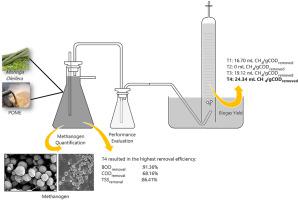Biomass & Bioenergy ( IF 6 ) Pub Date : 2020-11-28 , DOI: 10.1016/j.biombioe.2020.105885 Cheau Chin Yap , Soh Kheang Loh , Yi Jing Chan , Christina Vimala Supramaniam , Mei Fong Chong , Aik Chin Soh , Lian Keong Lim , Lian Siang Loo

|
Three main parameters of palm oil mill effluent (POME) i.e. biological oxygen demand (BOD), total suspended solids (TSS) and oil and grease (O&G), at high concentrations, have hindered efficient anaerobic digestion (AD) due to sludge flotation and scum formation. In this study, Moringa Oleifera extract was co-digested with POME to allow TSS and O&G to be coagulated and settled, and hence, an immobilisation media formed for better digestibility. Mono-digestion (POME, T1 and M. oleifera extract, T2, separately) served as control while co-digestion involved dosing 50 mL of M. oleifera extract (500 mg/L) into a fixed volume of POME (450 mL) at two feeding modes: daily, day 1 to day 30 (T3) and one-time, day 1 (T4). Treatments T1-T4 were conducted in an enclosed AD system for 30 days and the undesirable organic materials removal efficiencies i.e. BODremoval, TSSremoval and O&Gremoval were compared. POME co-digestion, T4, showed an improved 92% TSSremoval, 94% BODremoval and methane yield of 24.3 mL CH4/g COD removed. The results suggested that the nitrogen-fixing capabilities of anoxic microbial cells enhanced proliferation and growth encapsulated within the immobilisation media. Methanogen bacterial DNAs isolated from POME, granular sludge and anaerobically-treated POME were identified as Methanoculleus spp., Methanolinea spp. and Methanoculleus spp., respectively. Two-step complementary DNA (cDNA) and quantitative polymerase chain reaction (qPCR) confirmed the highest methanogen DNA concentration in T4. Therefore, the naturally occurring underutilised M. oleifera can be an organic coagulant for efficient POME co-digestion with an overall 69% and 59.5% higher methane yield and TSSremoval than mono-digestion.
中文翻译:

厌氧消化棕榈油厂废水(POME)与辣木提取物的协同效应
棕榈油厂出水(POME)的三个主要参数,即高浓度的生物需氧量(BOD),总悬浮固体(TSS)和油脂(O&G),由于污泥浮选和结垢而阻碍了有效的厌氧消化(AD)。浮渣形成。在这项研究中,辣木提取物与POME共同消化,以使TSS和O&G凝结并沉淀,因此形成了固定化的培养基,以提高消化率。单消化(POME,T1和油茶分枝杆菌提取物,T2,分别)作为对照,而共消化法则是将50mL的油茶分枝杆菌给药。提取(500 mg / L)到固定体积的POME(450 mL)中的两种喂养方式:每天第1天至第30天(T3)和一次性第1天(T4)。处理T1-T4在密闭的AD系统中进行了30天,比较了不良有机物去除效率,即BOD去除,TSS去除和O&G去除。POME共消化物T4显示出92%的TSS去除率,94%的BOD去除率和24.3 mL CH 4的甲烷产率提高/ g去除了COD。结果表明,缺氧微生物细胞的固氮能力增强了固定化培养基中封装的增殖和生长。从POME,颗粒污泥和经厌氧处理的POME中分离出的产甲烷菌细菌DNA被鉴定为Methanoculleus spp。,Methanolinea spp。和Methanoculleus spp.。两步互补DNA(cDNA)和定量聚合酶链反应(qPCR)证实了T4中最高的产甲烷菌DNA浓度。因此,天然存在的未充分利用的油菜分枝杆菌可以是有机凝结剂,用于有效的POME共消化,甲烷产率和TSS去除率分别提高69%和59.5% 比单消化。


























 京公网安备 11010802027423号
京公网安备 11010802027423号